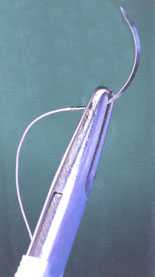Suture
|
|
Sutures are the stitches doctors, and especially surgeons, use to hold skin, organs, blood vessels and all other tissues of the human body together, after they have been severed in minor or major surgery.
Sutures are designed to help the healing of the body by closely opposing the two sides of a wound to minimize scar formation or to prevent leaking blood, like in vessels. They have to comply with several requirements to be effective. They must be strong (so they do not break), non-toxic and hypoallergenic (to avoid adverse reactions in the body), and flexible (so they can be tied and knotted easily). In addition, they must lack the so called "wick effect", which means that sutures must not allow fluids to penetrate the body through them from outside, which could easily cause infections.
| Contents |
Absorbable and nonabsorbable sutures
Absorbable sutures are made of materials which are metabolized inside the body after around three weeks, and then disappear. They are used therefore in many of the inner tissues of the body. In most cases, three weeks is sufficient for the wound to close firmly. The suture is not needed any more, and the fact that it disappears is an advantage, as there is no foreign material left inside the body. The disadvantage is that the foreign protein in some of the absorbable sutures create an inflammatory response by the body.
Absorbable sutures were originally made of the intestines of sheep, the so called catgut. The manufacturing process was similar to that of natural musical strings for violins and guitars, and also of natural strings for tennis racquets. Today, natural absorbable sutures are made primarily of bovine intestine. However, the major part of the absorbable sutures used are now made of synthetic fibers, like polyglycolic acid.
Nonabsorbable sutures are made of materials which are not metabolized by the body, and are used therefore either on skin wound closure, where the sutures can be removed after a few weeks, or in some inner tissues in which absorbable sutures are not adequate. This is the case, for example, in the heart and in blood vessels, whose rhythmic movement requires a suture which stays longer than three weeks, to give the wound enough time to close. Other organs, like the bladder, contain fluids which make absorbable sutures disappear in only a few days, too early for the wound to heal. Inflammation caused by the foreign protein in absorbable sutures can amplify scarring, so if removable sutures are less antigenic it would represent a way to reduce scarring.
There are several materials used for nonabsorbables sutures. The most common is a natural fiber, silk, which undergoes a special manufacturing process to make it adequate for its use in surgery. Other nonabsorbable sutures are made of artificial fibers, like polyester or nylon. Finally, there are also metal wires used in orthopedic surgery because of their strength and in some other tissues because of the metal's outstanding tolerance by the body.
Traumatic and atraumatic needles with sutures
Traumatic needles with sutures are those which are supplied to the hospital plain, i.e., the manufacturer supplies the suture thread and the eyed needle to use the suture as separate items. The suture must be threaded as it is done when sewing at home.
Atraumatic needles with sutures include an atraumatic or eyeless needle attached to a specific length of suture thread. The suture needle manufacturer swages the suture thread to the eyeless atraumatic needle at the factory. The advantages of having the needle mounted on the suture are several. The doctor or the nurse do not have to spend time threading the suture on the needle. More important, yet, is the fact that suture thread which is swaged using a hole at the end of the needle is smaller in size than the needle body. In traumatic needle with suture, the thread comes out of the needle's hole or eye on both sides. When passing through the tissues, this type of suture rips the tissue to a certain extent. With the atraumatic needle with suture this does not happen. They produce no trauma to the tissue, hence the name "atraumatic". Because of these advantages, the atraumatic needles with sutures are today very widely used.
There are several shapes of atraumatic needles, like straight, half curved, one-third curved, and others. The body of the needle is available also in different makes, like circular, with edge on the outer side, with edge on the inner side, and others.
Sizes of sutures
The sutures were originally manufactured ranging from #1 to #6. (To give an idea about these numbers, a #4 suture would be more or less the diameter of a tennis racquet string.) The manufacturing techniques, derived at the beginning from the production of musical strings, did not allow thinner diameters. As the procedures improved, #0 was added to the suture diameters, and later, thinner and thinner threads were manufactured, which were identified as #2/0 to #6/0. This last diameter, thinner than a human hair, was used during the last decades primarily for eye surgery. Now, there are even thinner sutures, down to #10/0. Atraumatic needles are manufactured in most of the shapes for all these sizes.
Types of sutures include
Simple Mattress Horizontal mattress Figure of 8 Continuous locking and non locking Subcuticular
See also
External links
- Comparison of different types of sutures on Tissue Reactivity and Knot Security (http://cal.vet.upenn.edu/surgery/5100.htm)
- Demonstration of suturing from medlib.med.utah.edu website (http://medlib.med.utah.edu/kw/derm/pages/prex_21.htm)pl:nici chirurgiczne

